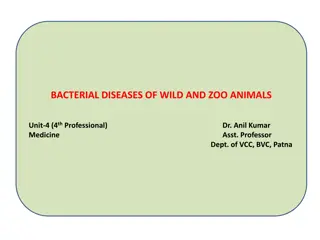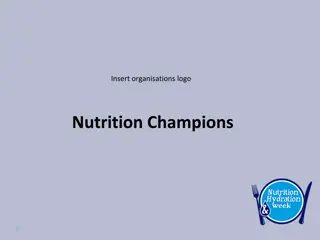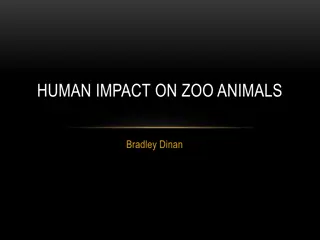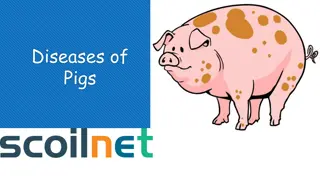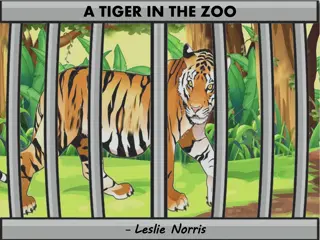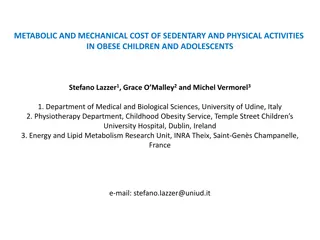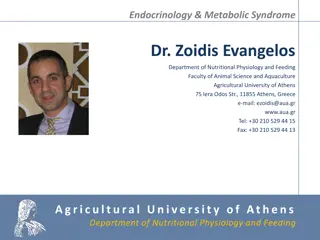Managing Nutritional and Metabolic Diseases in Zoo and Wild Animals
The prevention, control, and treatment of nutritional and metabolic diseases in zoo and wild animals are essential for maintaining their health. These diseases, such as rickets, osteoporosis, osteomalacia, and fibrous osteodystrophy, can result from imbalances in dietary nutrients and metabolic derangements. Factors like vitamin D deficiency, calcium insufficiency, and improper absorption contribute to the occurrence of these diseases. Effective management strategies involve addressing dietary deficiencies, enhancing calcium intake, and ensuring proper vitamin D supplementation.
Download Presentation

Please find below an Image/Link to download the presentation.
The content on the website is provided AS IS for your information and personal use only. It may not be sold, licensed, or shared on other websites without obtaining consent from the author. Download presentation by click this link. If you encounter any issues during the download, it is possible that the publisher has removed the file from their server.
E N D
Presentation Transcript
Prevention, control and treatment of nutritional and metabolic diseases of zoo and wild animals Part-I Dr. Vivek Kr. Singh Assistant Professor Department of Veterinary Clinical Complex
Metabolic Diseases mean the diseases that occur due to the imbalance between the rate of input of dietary nutrients and the output of products (product like new born, milk for young one etc.) and lead to the occurrence of metabolic derangements in the affected wild animal species
METABOLIC AND NUTRITIONAL DISEASES IN WILD ANIMALS RICKETS AND OSTEOPOROSIS OSTEOMALACIA AND FIBROUS OSTEODYSTROPHY METABOLIC BONE DISEASE SPECIES RICKETS GOUT HYPOTHYROIDISM DIABETES MELLITUS IN MAMMALS AND BIRDS FATTY LIVER IN MAMMALS AND BIRDS NEONATAL HYPOGLYCEMIA IN WILD ANIMALS KETOSIS (ACETONEMIA) IN WILD RUMINANTS LACTATION TETANY IN WILD EQUIDS PARTURITIENT PARESIS RUMINANTS IN CAPTIVE AVIARY (MILK FEVER) IN WILD
RICKETS AND OSTEOPOROSIS Rickets occurs due to lack of vitamin D3 In case of rickets, malformation of the growing bone (bowing of limbs/curving in limbs) occurs Osteoporosis occurs in both the adults and juveniles (but may be frequent in senile female reptiles) Already hardened bones become weakened by the withdrawal of purposes and the wild animals become more prone for the development of fractures calcium for metabolic
OSTEOMALACIA AND FIBROUS OSTEODYSTROPHY These disorders are often seen in the young hatchlings of crocodiles which subsequently reveal failure of hardening of bones due to lack of calcium Among mammals, bone eaters (eg. hyaena) if deprived of bones during feeding will end up in metabolic bone diseases
Etiology Feeding diet with less calcium (provision of mince with liver and heart without bone or with less bones) Failure in proper absorption of calcium (diseases of GI tract / excessive phosphorus in diet) Insufficient calcium supplement imbalances due to multiple causes Lack of vitamin D esp. in indoor-kept wild animals. Prolonged storage of ration leads to less vitamin D3 and hormonal
Clinical signs Persisting appearance) esp. in subadults and adult crocodiles Weakness of hatchling to walk on land while they still can move freely if in water or can swim freely in water Falling of teeth and poor calcification of teeth Jaw bones become more pliable as evidenced in case of hatchlings(rubber jaws) Weakness in hatchlings movements In chelonians, lump like appearance of (compare with normal nearby chelonian) of kyphokoliosis ( hunch backed along with sluggish carapace
Diagnosis Clinical signs and history of feeding and management Radiographical examination Serum estimation of calcium and phosphorus






